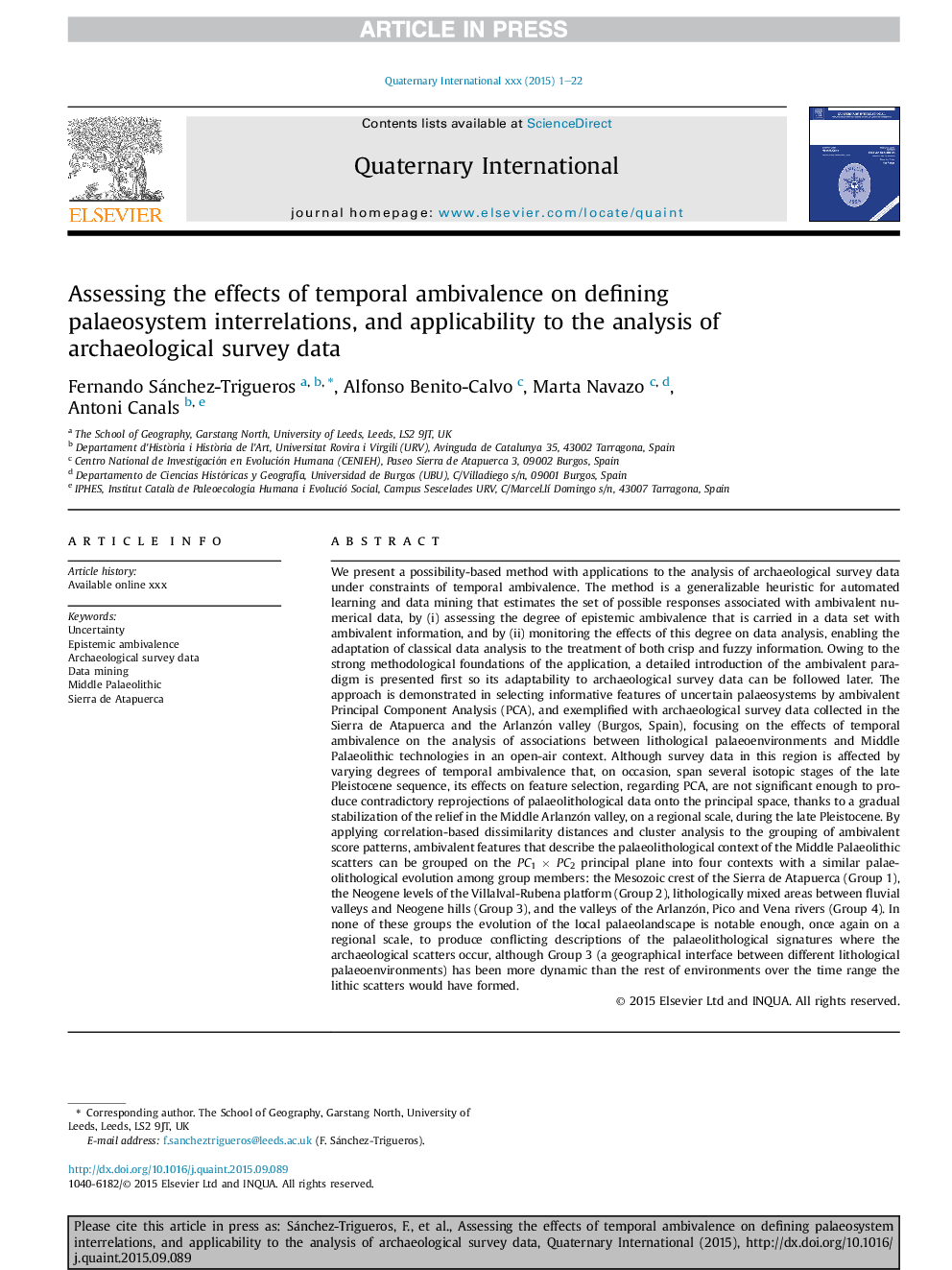| کد مقاله | کد نشریه | سال انتشار | مقاله انگلیسی | نسخه تمام متن |
|---|---|---|---|---|
| 5113262 | 1377922 | 2017 | 22 صفحه PDF | دانلود رایگان |
عنوان انگلیسی مقاله ISI
Assessing the effects of temporal ambivalence on defining palaeosystem interrelations, and applicability to the analysis of archaeological survey data
ترجمه فارسی عنوان
ارزیابی اثرات دوگانگی زمانی بر تعریف ارتباطات پراسئیستی و کاربرد آن در تجزیه و تحلیل داده های تحقیقات باستان شناسی
دانلود مقاله + سفارش ترجمه
دانلود مقاله ISI انگلیسی
رایگان برای ایرانیان
کلمات کلیدی
عدم قطعیت، دیوانگی معرفتی، داده های تحقیق باستان شناسی، داده کاوی، پایه میانی مرکزی، سیرا د آتاپورکا،
موضوعات مرتبط
مهندسی و علوم پایه
علوم زمین و سیارات
زمین شناسی
چکیده انگلیسی
We present a possibility-based method with applications to the analysis of archaeological survey data under constraints of temporal ambivalence. The method is a generalizable heuristic for automated learning and data mining that estimates the set of possible responses associated with ambivalent numerical data, by (i) assessing the degree of epistemic ambivalence that is carried in a data set with ambivalent information, and by (ii) monitoring the effects of this degree on data analysis, enabling the adaptation of classical data analysis to the treatment of both crisp and fuzzy information. Owing to the strong methodological foundations of the application, a detailed introduction of the ambivalent paradigm is presented first so its adaptability to archaeological survey data can be followed later. The approach is demonstrated in selecting informative features of uncertain palaeosystems by ambivalent Principal Component Analysis (PCA), and exemplified with archaeological survey data collected in the Sierra de Atapuerca and the Arlanzón valley (Burgos, Spain), focusing on the effects of temporal ambivalence on the analysis of associations between lithological palaeoenvironments and Middle Palaeolithic technologies in an open-air context. Although survey data in this region is affected by varying degrees of temporal ambivalence that, on occasion, span several isotopic stages of the late Pleistocene sequence, its effects on feature selection, regarding PCA, are not significant enough to produce contradictory reprojections of palaeolithological data onto the principal space, thanks to a gradual stabilization of the relief in the Middle Arlanzón valley, on a regional scale, during the late Pleistocene. By applying correlation-based dissimilarity distances and cluster analysis to the grouping of ambivalent score patterns, ambivalent features that describe the palaeolithological context of the Middle Palaeolithic scatters can be grouped on the PC1Â ÃÂ PC2 principal plane into four contexts with a similar palaeolithological evolution among group members: the Mesozoic crest of the Sierra de Atapuerca (Group 1), the Neogene levels of the Villalval-Rubena platform (Group 2), lithologically mixed areas between fluvial valleys and Neogene hills (Group 3), and the valleys of the Arlanzón, Pico and Vena rivers (Group 4). In none of these groups the evolution of the local palaeolandscape is notable enough, once again on a regional scale, to produce conflicting descriptions of the palaeolithological signatures where the archaeological scatters occur, although Group 3 (a geographical interface between different lithological palaeoenvironments) has been more dynamic than the rest of environments over the time range the lithic scatters would have formed.
ناشر
Database: Elsevier - ScienceDirect (ساینس دایرکت)
Journal: Quaternary International - Volume 435, Part B, 12 April 2017, Pages 13-34
Journal: Quaternary International - Volume 435, Part B, 12 April 2017, Pages 13-34
نویسندگان
Fernando Sánchez-Trigueros, Alfonso Benito-Calvo, Marta Navazo, Antoni Canals,
